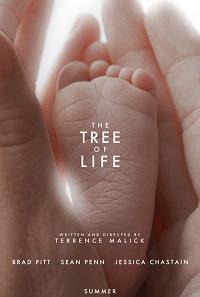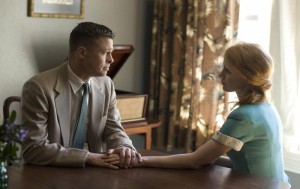
ABSENCE GROWS MYSTERY
If Terrence Malick is a saint of cinema, then this is his holy lesson. Over a four-decade career, the mercurial American visionary has mastered absence and flowered a daunting mystery. After making one of the most impressive debuts in American film history, 1973’s Badlands, he quit talking to the press. After the dreamy masterpiece Days of Heaven five years later, the perfectionist dipped a toe back in and quickly removed it. He then famously disappeared for 20 years.
Swathed in stunning cinematography, pieced together by mood and memory (rather than linear story), The Tree of Life is a radical contemplation of mystery. These mysteries take forms from childhood curiosities to cosmic riddles, stretching from the Big Bang to a fifties Texas family and on to the end of time.
 Michael Phillips, the Chicago Tribune critic, calls The Tree of Life “an infinitely more forgiving 2001: A Space Odyssey.” Critics and viewers will find a natural similarity with Tree’s centerpiece, an already famous 20 minute pre-historic spectacular, sketching the origins of the universe and the planet Earth. Stars, cells, seas, volcanoes, trees, sharks, jellyfish, and, yes, dinosaurs. This section, though, seems to be a critique of 2001 rather than agreement. If Kubrick were still with us, he might feel the need to reply.
Michael Phillips, the Chicago Tribune critic, calls The Tree of Life “an infinitely more forgiving 2001: A Space Odyssey.” Critics and viewers will find a natural similarity with Tree’s centerpiece, an already famous 20 minute pre-historic spectacular, sketching the origins of the universe and the planet Earth. Stars, cells, seas, volcanoes, trees, sharks, jellyfish, and, yes, dinosaurs. This section, though, seems to be a critique of 2001 rather than agreement. If Kubrick were still with us, he might feel the need to reply.
As a philosophy student at Harvard and Oxford, Malick studied the German thinker Martin Heidegger. Like a philosopher, Malick interprets 2001’s “Dawn of Man” sequence (aka “the part with the apes”) as an imagined “state of nature.” When Kubrick’s ape strikes another with a bone, the notorious pessimist suggests human consciousness arises from intelligence and violence. In reply, Malick’s dinosaur comes across a partner and thinks about making a meal of it. Instead, it senses its suffering and moves on. This is the “Dawn of Empathy,” and The Tree of Life gives us consciousness born of love. We soon jump-cut across eons not to an orbiting military satellite but to a pregnant woman’s belly.
Still, it’s not all sunshine and dandelions and epic amounts of oak wood. Love arises as the twin of suffering and the realization of death. Why do we suffer? Why do we love if it only ends in suffering? Malick’s characters live a precarious distance from the divine. They can sense it through love and beauty, but feel estranged from it due to loss and death. Playing the film’s angelic mother, the flame-haired actress Jessica Chastain points to the sky and tells her child, “That’s where God lives.” This is a myth we tell children to make concrete those things that, if they exist, hide in a divine realm. In other words, mystery.
 “What are we to you?” she demands, as she bears the loss of her grown son. Without words, she wanders through the streets and lawns of her neighborhood. We skip quickly between images of comfort and distress, as The Tree of Life opens with a potent rush of grief and nostalgia. The editing makes clear that these are moments imagined years later by a spiritually fried architect, crawling through a maze of glass towers in a modern Texas city.
“What are we to you?” she demands, as she bears the loss of her grown son. Without words, she wanders through the streets and lawns of her neighborhood. We skip quickly between images of comfort and distress, as The Tree of Life opens with a potent rush of grief and nostalgia. The editing makes clear that these are moments imagined years later by a spiritually fried architect, crawling through a maze of glass towers in a modern Texas city.
In a moment of unspecified anguish, the architect Jack (Sean Penn – you can tell Malick puts much more thought into his metaphysics than his character names) dwells on his mother’s suffering after the death of his brother. In endlessly beautiful images from cinematographer Emmanuel Lubezki, his memory collects images of his youth with his three brothers, enjoying bike rides and throwing footballs deep into the gigantic sky. The splendor of youth is presided by the sweet light of his mother, who he thinks is a saint. I don’t mean figuratively. He envisions her floating in the air near a tree. It is through her, he says in voiceover, that God first spoke to him.
His father (played by an all-in Brad Pitt) is a loving tyrant. He pushes the boys with strong discipline, especially the oldest, believing it will toughen them for the real world. As he grows, Jack (played as a child by Hunter McCracken, whom everyone feels obliged to call “jug-eared”) struggles to reconcile the world’s beauty with hardship, injustice, and his first taste of death. Confused by life’s random pitfalls, he tells God that he wishes he could see the world as He does.
 Different observers have different things to say about this portrait of family life in small-town Texas, a Book of Job drawn from Malick’s real life. What strikes me is the seriousness that children place in their first experiences. Every first time seems like a miracle or a sin. Every small event has cosmic importance. Every act seems like a weighty revelation of the soul.
Different observers have different things to say about this portrait of family life in small-town Texas, a Book of Job drawn from Malick’s real life. What strikes me is the seriousness that children place in their first experiences. Every first time seems like a miracle or a sin. Every small event has cosmic importance. Every act seems like a weighty revelation of the soul.
Religiously, I would place Malick as a skeptical Christian. At times, he seems like a man from another time, a monk slaving over a text in a medieval monastery (which would deprive him of his mammoth gifts as a filmmaker). While open to all, his films are like spiritually rich biblical stories from the modern age. It’s like the Bible never stopped. We simply stopped writing it.
In this, I think The Tree of Life shares a mission with 2001: each is an effort to resolve ancient wisdom and modern thinking. It does so by introducing us with renewed eyes to a world of beauty and suffering. It promises the meaning of life. It substitutes the awe of experience.
kevinbowen @ stageandcinema.com
The Tree of Life
rated PG-13
now playing in select theaters

{ 1 comment… read it below or add one }
We are not too far from the scratching on the cave walls. If anything this movie is the technological creation by the use of the tools at hand. It uses all the resources available since the advent of a deity to express the consciousness of what can best be described as this animal called human. The cinematic canvas of the beginnings at least as I see them, shows the power manifested. against that is man whose power begins at each birth and is brought into the play of civilization. By defining it in numbers such as 1949 we as the audience interpret the images as we understand them in out evolution of consciousness. That for me is brilliance of the movie.